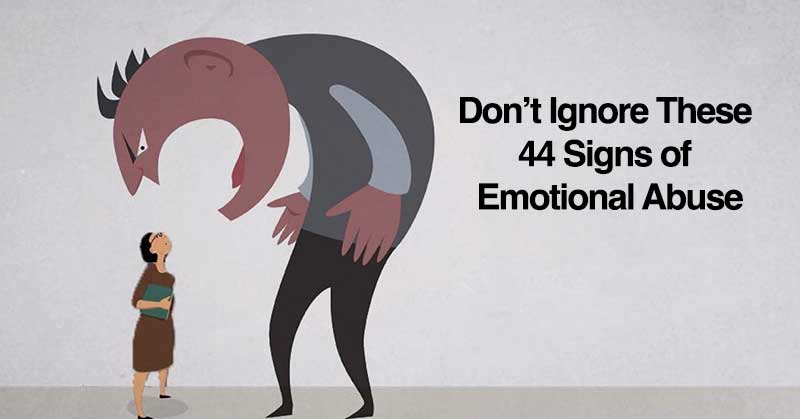Recognizing the signs of abuse is crucial for safeguarding personal well-being and fostering healthy relationships. From subtle manipulations to overt aggression, these indicators serve as vital red flags demanding attention and action. Whether it’s emotional coercion, physical violence, or financial control, no form of abuse should be dismissed or tolerated. By acknowledging these warning signs and seeking support from trusted individuals or professional resources, individuals can empower themselves to break free from abusive dynamics and cultivate environments of respect, dignity, and safety.
Examples of humiliation, negating, and criticizing

In the realm of emotional abuse, various insidious tactics are employed to undermine an individual’s sense of self-worth and control their behavior.
Verbal Insults:

Examples include name-calling, mocking, and using hurtful language to belittle the victim, eroding their self-esteem.
Gaslighting:

Manipulating someone into doubting their perceptions, memories, or sanity, causes confusion and self-doubt.
Isolation:

Limiting access to friends, family, or support networks, fostering dependence, and controlling the victim’s social interactions.
Constant Criticism:

Frequently pointing out perceived flaws, mistakes, or shortcomings to undermine the victim’s confidence and sense of self-worth.
Threats and Intimidation:

Expressing or implying physical harm, making the victim feel unsafe, or using fear as a means of control.
Financial Control:

Restricting access to money, controlling finances, or sabotaging economic independence to exert power and limit autonomy.
Emotional Neglect:

Withholding affection, emotional support, or validation, leaves the victim feeling unloved, unworthy, or abandoned.
Manipulation:

Using deceit, guilt-tripping, or playing mind games to influence the victim’s thoughts, feelings, or actions.
Public Humiliation:

Disparaging or ridiculing the victim in public or private settings, erodes their dignity and causes shame.
Blaming and Shifting Responsibility:

Assigning blame for problems or difficulties to the victim, deflecting responsibility for the abuser’s actions.
Control of Communication:

Monitoring or controlling the victim’s communication channels, such as restricting access to phones or the internet.
Emotional Blackmail:

Using emotional manipulation to gain compliance, often by threatening to reveal sensitive information or secrets.
One of the most common signs of abuse – Invalidation:

Dismissing the victim’s feelings, experiences, or opinions makes them feel insignificant or unworthy.
Stonewalling:

Refusing to communicate or engage in discussions leaves the victim feeling ignored, isolated, and invalidated.
Humiliation and Degradation:

Engaging in acts or comments that demean the victim, attacking their dignity and self-respect.
Examples of Shame:

Weaponization of shame is a destructive tactic used to exert control and manipulate victims.
Public Humiliation:

Disparaging or ridiculing the victim in public to shame and degrade them.
Body Shaming:

Making hurtful comments about the victim’s appearance or body to induce feelings of inadequacy.
Criticism of Abilities, a rather frustrating sign of abuse:

Constantly undermining the victim’s skills, talents, or capabilities, eroding their self-confidence.
Cultural or Racial Shaming:

Using derogatory language or stereotypes related to the victim’s culture or race to induce shame.
Read More: 7 Signs of a Toxic Family
Guilt-Tripping:

Manipulating the victim by inducing guilt for their actions or choices.
Labeling and Name-Calling:

Assigning negative labels or using derogatory names to demean and shame the victim.
Public Exposure of Secrets:

Revealing private information or secrets to embarrass and humiliate the victim.
Emotional Blackmail:

Using emotional manipulation to make the victim feel responsible for the abuser’s emotional state.
Blaming for Abuse:

Blaming the victim for the abuse, suggests they deserve it.
Intimate Shaming, a hurtful sign of abuse:

Using intimate details to shame the victim, creates feelings of embarrassment or degradation.
Invalidation of Feelings:

Dismissing the victim’s emotions or experiences, and making them feel their feelings are unwarranted.
Parental Guilt:

Exploiting parental insecurities, making the victim feel guilty or inadequate as a parent.
Criticizing Life Choices:

Judging and shaming the victim for their life choices, including relationships, career, or personal goals.
Social Exclusion:

Deliberately excluding the victim from social activities or events to isolate and shame them.
Examples of Accusing Blame and Denial:

Accusing blame involves unfairly assigning responsibility to the victim for problems or issues, fostering a sense of guilt and inadequacy.
Blaming the Victim – a common sign of abuse:

Shifting responsibility for abusive behavior onto the victim, making them feel at fault for the mistreatment.
Denial of Abuse:

Flatly rejecting or minimizing the existence of abuse, dismissing the victim’s experiences and emotions.
Read More: 7 Parenting Mistakes Everyone Should Try to Avoid
Projecting Fault:

Attributing one’s negative traits or actions to the victim, deflecting accountability for wrongdoing.
Accusing the Victim of Exaggeration:

Dismissing the severity of the abuse by accusing the victim of exaggerating or fabricating their experiences.
Gaslighting Through Denial:

Using denial as a form of gaslighting, causes the victim to question their perception of reality.
Blaming External Factors:

Attributing abusive behavior to external factors (stress, substance abuse) rather than taking personal responsibility.
Manipulative Apologies:

Offering apologies without genuine remorse, using apologies as a means to manipulate and avoid accountability.
Victim-Blaming:

Holding the victim responsible for the abuse, suggesting they somehow provoked or deserved the mistreatment.
Selective Memory and Forgetfulness are a sign of abuse:

Claiming forgetfulness or memory loss to avoid acknowledging specific instances of abusive behavior.
Blaming Mental Health:

Attributing abusive actions to mental health issues without taking responsibility for seeking help or change.
Denying the Impact:

Downplaying or denying the emotional, physical, or psychological impact of the abuse on the victim.
Minimizing Accountability:

Avoiding accountability by downplaying the significance of one’s actions or their role in the abusive dynamic.
Blaming Cultural Norms:

Excusing abusive behavior by attributing it to cultural norms, societal expectations, or upbringing.
Denying Intent:

Claiming that abusive actions were unintentional, denying the deliberate harm caused to the victim.
Deflecting Blame Through Comparison:

Comparing one’s actions to others in an attempt to minimize responsibility and avoid blame for abusive behavior.
In conclusion, the presence of any of these signs of abuse should never be overlooked or minimized. They serve as critical markers of unhealthy dynamics within relationships, signaling the need for intervention and support. By acknowledging and addressing these warning signs, individuals can reclaim their autonomy, protect their well-being, and strive towards relationships built on mutual respect and trust. Ignoring these signs only perpetuates cycles of harm, while confronting them paves the way for healing and empowerment.
Read More: Anxiety Disorders May Be Caused By Exposure To Narcissistic Abuse
Sources
- “How to Recognize the Signs of Emotional Abuse” HealthLine. Ann Pietrangelo and Crystal Raypole. July 13, 2023.
- “Are You Experiencing Emotional Abuse and Not Aware of It?” Psych Central. Hope Gillette. February 7, 2022.

